|
Click on the map to see a full page view of our trip. |
|
|||||||||||||||||||
|
|
||||||||||||||||||||
|
Egypt |
||||||||||||||||||||
|
||||||||||||||||||||
|
|
||||||||||||||||||||
|
Milan |
||||||||||||||||||||
|
||||||||||||||||||||
|
Click on the map to see a full page view of our trip. |
|
|||||||||||||||||||
|
|
||||||||||||||||||||
|
Egypt |
||||||||||||||||||||
|
||||||||||||||||||||
|
|
||||||||||||||||||||
|
Milan |
||||||||||||||||||||
|
||||||||||||||||||||
| Before we get
started with the pictures & stories, we would like to thank a friend of
Hosam's (our Cairo guide) - we have forgotten this man's name, but he gave
us great ways to remember how to say a few very important words...
Thank you:
Think of a pole you lean against and get shocked - your instant reaction
would be to run. "Thank you" sounds like "shock-run." What is your
name?: Think of a mug that has two handles - hang the letter S on
the left handle and the letter A on the right. Say the letter's names with
the word mug in the center. "What is your name?" sounds like "S-mug-A" Hatshepsut (she was the Queen who would be King): Her name was impossible to remember or say till we were told to sort of slur the following three words together - hat+cheap+suit. Much easier! |
| Day 1 - June 25th | ||
|
|
We booked our tour with Nebila Tours / El Naggar Travel - a fabulous company! So, after over 20 hours of travel, K&K and Bob & Amy arrived in Cairo and were met by our trip coordinator, Muhammad Mager. We had a fairly short drive to the Cairo Sheraton where Mohammad checked us in and reviewed our itinerary. It was late afternoon, so we decided to get a good night's rest & start early the next morning. |
|
| Day 2 - June 26 | ||
|
Early in the morning, Mohammad
introduced us to Sam, our guide while we were going to be in Cairo. (His
real name is Hosam Eldin Ebranim Gedawy - we just called him Sam.) We
introduced Sam to K&K - he was delighted to meet them. Sam was one of the
best guides we have had on any of our travels. He is working on his
Master's Degree, is married to a lovely lady who is a criminal lawyer in
Egypt, and has a wonderful sense of humor. K&K fell in love with him
immediately!
President Mubarak was going to be in town where we were scheduled to visit, so we changed our itinerary to go to the pyramids on the first day rather than at the end of our trip. That worked WONDERFULLY for us! |
||
|
|
|
|
|
Our first stop was to visit the Giza
Plateau & to walk around the "Great Pyramid," built for King Khufu
around 2,550
B.C. It is the the largest of the pyramids there, and is known as Cheops
by the Greeks. It was built with over 2 million stone blocks that each
weighed an average of 2 1/2 tons and took 23 years to complete. Originally it was 481 feet tall, but
some of the blocks are missing from the top now, so today, it stands at
about 450 feet high. The third picture above shows K&K and Bob & Amy
standing a few levels up on the pyramid - the blocks were HUGE! |
||
|
The first picture below is of the "back
side" of the all the pyramids on the Giza Plateau. The Great Pyramid (Khufu/Cheops)
is the first one on the left.
The second pyramid is Chephren, built for King Khafre (Khufu's son). It looks much bigger even though it is not. Khafre had it built on a higher plateau to give it the illusion of a larger size. It is the one that still has some of the casing stones (called the cap stones by many). These were the stones that totally covered each pyramid with a smooth white polished look. Originally the very top was covered in a gold like metal that reflected the sun and honored the gods. We got to go inside this pyramid - it was great. The third pyramid is the smallest and was built for King Menkaure. It is very special in that it has 3 rather weathered smaller pyramids in front of it for his ladies (seen at the far right of the first picture). |
||
|
|
|
|
| While we were there, Sam found us a guide and some camels to ride into the desert. We circled around to the front of King Khafre's pyramid (the middle one with the cap stones). The ride was about 30 minutes. K&K stayed with Amy on the lead camel who was named Charlie, while Bob rode trail on Moses. | ||
|
Charley, Amy's camel, said an Egyptian "howdy" to K&K. They liked it, but
Amy looked a bit unnerved! Charley also said hi to Bob - they seemed to like each other right away. |
|
|
|
|
||
|
|
|
The Sphinx is believed to be the face of King Khafre with a body of a lion symbolizing his power on earth. In the past it was thought that Napoleon's army used it as target practice. Now it seems that the Mamluk army was responsible for shooting his nose off. |
| We drove
to Memphis - the ancient capital of Egypt - to see the Alabaster Sphinx,
reclining statue of Ramses II, & the Step Pyramid of King Zoser at
Sakkara.
The size of the statue of Ramses II was incredible - Bob & K&K are standing at the far end of the statue - you can hardly see them! |
|
|
In the close up view on the right, we talked about the cartouches placed on the statue's body. They, of course, showed the name of the person - rather like a signature today. But Kini & Kimi thought they looked a lot like the tattoos that people get today. Who knows? Much of our culture dates to the ancient times - maybe these were the original form of our current tattoos! |
||
|
|
|
Next we went to the Step Pyramid of King Zoser at Sakkara. It was one of the first pyramids ever built. The King kept changing the plans - expanding the design. If you look closely, the left side is a bit longer - out of proportion to the right side. The architect was the famous Imhoptep. |
| The second pyramid was built by a king who did not have as much money to put into building it. It has severely eroded. As Sam, the guide said, "You get what you pay for!" | ||
|
|
Papyrus is the ancient type of paper. It was hand made using the stocks of the papyrus plant. It is hard to see, but on the right hand side of the woman is a small papyrus plant that she cut up, soaked, and showed us the steps the ancients used to make their paper. Behind her are examples of new paintings and images from the temples on real papyrus scrolls. | |
| Okay -
even K&K thought the laser light show at the pyramids was "very touristy."
However, it was also very COOL! The Pharaohs & Kings tell their stories, the Sphinx echoes words from ancient papyrus scrolls, & images play over the stone walls. This is a must do! |
|
|
|
We got back to the
hotel late - with a spectacular first day under our belt. |
||
| Day 3 - June 27 | ||
| Early
in the morning we all got up and repacked to catch our next few flights.
From Cairo we flew to Aswan, & from Aswan to Abu Simbel. We were on our
own here - the guide that dropped us off simply said find the bus and an
English speaking tour guide - he will make sure you get back to the
airport on time to catch your flight back. Humm... Okay.
Because the High Dam was built,
Lake Nasser was created. In order to preserve the temples & monuments,
many had to be moved stone by stone to higher land. Abu Simbel was one of
these. They literally carved the monument out of the rock wall and moved
it to the top of the cliff - away from the rising waters. You can still
see the curved area the lake now half buries where the monument originally
stood. Impressive! |
||
|
|
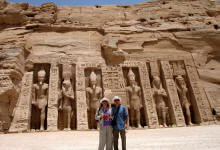 |
|
| Abu Simbel seemed to us to be one of the hottest places on this earth. While we were there it reached 115 degrees Fahrenheit. These are the Temples of Ramses II & the Nubian Queen Nefertari. They are HUGE - as is everything built by the ancient Egyptians. We all knew that the temperatures would be in the triple digits and the humidity in the single digits. Before leaving, K&K spent many hours with Amy on the internet trying to find out if there were any products on the market that might give one some cooling relief in the middle of a major heat wave. We bought & brought two. The one time squeeze packs that are used to "ice" sprains last up to 30 minutes in air-conditioned environments of the U.S. In Abu Simbel, at 115 degrees, they last possibly 4 minutes of major cold - 2 minutes of cool - & 2 minutes of "this is not as hot as the water I'm carrying to drink." Then ... they seemed to absorb the heat and grow hotter - a total of 6 minutes of cold to cool is not worth the secure packing needed to get them there without activation. Great science experiment - not a good choice for travel. We also tried the "Be Kool" strips for migraine headaches. The design is nice - a water infused gel patch that sticks to your skin is supposed to give you a cooling evaporation effect. It does - inside with the air-conditioning running. In extreme heat, you may feel a spot of cool, but severe sweating makes the patch a feel a bit weird and does not give an overall cooling feeling. However, it does last a lot longer - possibly an hour if you jump into and out of an air-conditioned van. Basically - the best way to stay as cool as possible is to stick to the shade, wear loose, light clothing, and don't stay out in the heat for extended periods of time. We then flew back to Aswan to board our Nile cruise ship, The Queen of Sheeba. After settling in & meeting our new guide, Aladdin, we took a felucca (a small sail boat) around the Nile. The first picture shows our ship in the background. The second, shows the Nubian house we got to tour. Open roofs (very little rain) and dirt floors covered with sturdy rugs. Then two children paddled out to our felucca to sing us the sweetest songs with angelic voices. After a bit of money and huge smiles they hitched a ride on the back of our boat till the next came along. We also saw Elephantine Island - one of the major sites from the "River God" novel by Wilber Smith. |
||
|
|
|
|
| Day 4 - June 28 | ||
| The Philae
Temple complex was added onto for over 800 years. It is on an island and
was primarily dedicated to Isis, although smaller temples are dedicated to
Isis' son, Horus, & the goddess Hathor. In the sixth & seventh centuries
A.D., the temple was used to celebrate the ancient gods, Christ, and the
Virgin Mary.
This temple complex was moved stone by stone to a higher island when the High Dam was built. The last picture below shows Trajan's Kiosk. When the statue of Isis made its annual journey down the Nile it would land at Trajan's Kiosk. |
||
|
|
|
|
|
|
Kini & Kimi decided to take a short walk into in Sahara Desert. Their little feet got very hot! Then we saw the 1st cataract where rocks block the Nile until the flood season. Of course, now that the High Dam has been built, and the water level is constant, these rocks are never underwater anymore. |
|
| An obelisk is a tall
four-sided column with a pyramid style top. They were cut out of a single
slab of stone and transported down the Nile. The Unfinished Obelisk cracked when the workers were carving it out, so they stopped working on it and left it in place. It is still attached to the rock on the bottom side. When finished, it would have weighed over 1216 tons or 2.4 million pounds and stood 137 feet tall. |
|
|
|
|
|
In the afternoon, we sailed to Kom Ombo
to see the Twin
Temples of Horus & Sobek. Sobek is usually pictured with a
crocodile head. Inside the temples were mummified crocodiles.
Later that evening, we sailed to Edfu & docked for the night. |
| Day 5 - June 29 | ||
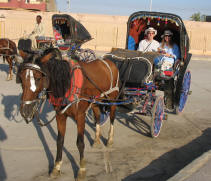 |
After a
horse-drawn carriage ride through the town of Edfu, we arrived at the
Temple of Horus. Bob had chosen Horus as his primary Egyptian god. Amy
chose Hathor. When we arrived and found out that both our gods were
honored here, we were delighted. Sam was still our guide - K&K and Amy
wanted a picture with him in front of the temple. This is the second largest temple (the first is in Karnak). Once a year the temple became a meeting place for Horus and his wife Hathor. One of the etchings shows the Feast of the Beautiful Meeting between the two. Hathor's priestesses would put her statue on a barge and send it to Horus' Temple so they could be together. |
|
|
|
|
|
|
|
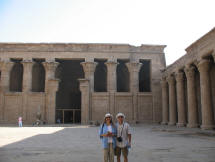 |
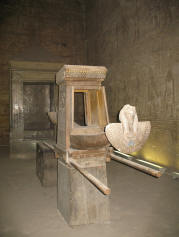 |
|
After returning to the cruise ship, we set sail for Luxor. The Nile is life to the Egyptians. It is spectacular. Green, fertile valleys abruptly end in desert and cliffs. Sugar cane and grains are carried on donkey back. And the villages line the River. The Nile and the New River in southwest Virginia are the only two rivers that flow from the south to the north. Consequently, Upper Egypt is in the south and Lower Egypt is in the north. |
||
|
|
|
|
| Day 6 - June 30 | ||
|
|
The Valley of the Kings & the Valley of the Queens are located in Luxor on the west side of the Nile - the side where the sun sets - the ancients believed this was a symbol of death. A tram would take you to from the parking lot to the start of the valley. In 90 to 100+ temperatures, it was greatly appreciated. The valleys were chosen for their security, their symbolic landmarks, and sturdy rock. Some tombs are very large, some rather small. We asked why and were told that the smaller tombs usually meant that the King had died earlier then expected and the tomb had to be finished faster then expected. The tombs were incredible. The colors were bright. Many of the paintings and cartouches were both carved and painted. We went through
three tombs; #1 - Ramses VII, In the Valley there were tombs for other important people of the time - many were built high in the cliffs. The circle on the left shows people who took a donkey up to the tomb but had to walk back - it was so steep the donkeys couldn't carry them down. On the right is
Bob working an ancient type drill to bore out the center of an |
|
|
|
|
|
|
|
|
|
|
|
|
|
|
|
|
Our next stop was at Queen Hatshepsut's funeral temple. Carved from the cliff, it is an amazing feat of workmanship. She ruled Egypt for about 20 years while Thutmose III grew to age. She was the first known female monarch and had her pictures shown with the false beard of a Pharaoh and the royal headdress. Many of her images were destroyed when her son took the throne - this was a common way to try to erase the memory of a person after they died. She lived from
1490 B.C. to 1468 B.C. The temple was built by Senenmut in from about 1504
to 1483 B.C. It has three terraces imitating the pyramid style and stands
almost 920 feet. |
|
|
||
|
The Temple of Amon in the city of
Karnak is considered to be one of the best examples of ancient temples.
The scale of the columns and buildings are incredible. The entrance is
lined with beautiful lion-headed sphinxes. In the courtyard, there are 134
columns, each 69 feet high, it is still the largest religious room ever
built. It is said that ten average European cathedrals would fit within
the Amon enclosure which is over 61 acres in size. The main construction
started in the 16th century B.C. and some 30 pharaohs added buildings and
temples to it over the decades.
|
||
|
|
|
|
|
|
|
|
|
Above, Bob and K&K
are standing by one of the huge pillars. On the right side is and etching
in relief of Pharaoh Ramses bending down before the "tree of life." He is
holding his own cartouche and asking Thoth, the scribe, shown as an
Ibis-headed god in charge of writings and records, to add more of his
cartouches to the the tree. The idea was that each leaf on the tree
represented every living being on earth. When the leaves turned yellow and
dropped from the tree, the person would die. The Pharaoh wanted to have a
lot of leaves so that he would have a very long life. |
||
|
|
K&K got to crawl into the deeply carved hieroglyphics to have their pictures taken. The obelisk at Karnak was huge - we had to keep reminding ourselves that this was a single cut stone of granite, weighing over 300 tons, that was transported via the Nile by the ancients. And then, it was raised to a standing position and has stood there for 3,000 years! |
|
|
The Luxor Temple also has a walkway lined with sphinxes, however, these have the head of Pharaoh Ramses rather than ram's heads. Sam, our guide told us that Ramses would come into the temple of Karnak as a Ram - an animal representation of the male power. He would then leave via the Nile and make a circuit back to the temple in man form - still with the body of a lion to show his earthly powers. See K&K in the red circle? |
||
|
|
||
|
|
|
|
|
The avenue is wonderful. We also got to see a mosque that sat on the edge of the excavations. In the photo, you can see where the the new building (the smooth part) was built above the ancient sites. |
||
|
Kimi & Kini got to sit on an ancient mud brick wall - it was interesting to see the straw mixed with the mud and to know that these bricks have survived the ages because of the lack of rain. Then Aladdin took us to the local place that had water cooled tobacco pipes and coffee or tea. We stayed the night at the St. George Hotel - it was lovely. |
|
|
| Day 7 - July 1 | ||
|
Today we celebrated our 23rd wedding anniversary! We had a very early start to fly to back to Cairo, where Sam & Muhammad were there to meet us. |
||
|
|
Sam took us to the Alabaster Mosque (the Citadel of Salah al-Din). It was impressive. He explained to us the Muslim ways. We learned so much about the Egyptian culture and its religions. While there, Amy got a chance to photograph two women in the traditional full-faced black robes. These women dress this way to show their devotion to their God and religion. |
|
|
|
The Pyramid of Snefru (Bent Pyramid) at Dahshur was an incredible sight. The casing stones are mostly intact, and the pyramid has an unusual bend to it. Sam told us that the original plans for the pyramid had a 53 degree slope. But then a combination of factors caused the designers to redesign the top part. Whether it was cost, stability, or a need to finish faster, new plans were drawn up and built. The base slopes at 53 degree angle, the top slopes at 43 degrees. The Great Pyramid slopes at a 53 degree angle. After building the bent pyramid, Snefru decided that it didn't have the harmony in design he wanted, so he built a second pyramid a short way away. This one is now called the Red Pyramid. Today, many archeologists believe that Snefru was probably buried in the bent pyramid. He is one of the few, if not the only Pharaoh, to have completed two pyramids in his life time. Also in this area is what is called the "Black Pyramid." It was actually blown up in an effort to find the entrance to the pyramid. |
|
|
|
We celebrated the evening of our anniversary at a Whirling Dervish show - followed by a dinner in the Old Town. These men whirled for 30 to 45 minutes without stopping. The music was delightful as well. Muhammad brought us a bust of King Tut in exquisite wood for our anniversary. We were so surprised and so happy. It has a place of honor at home - we see it and have to grin! |
|
|
|
||
| Day 8 - July 2 | ||
|
In the morning, we took the "Desert Road" to Alexandria - located in the north (lower Egypt) and in the Delta region on the Mediterranean Sea. |
||
|
|
|
|
| In the National Museum of Alexandria, we were able to take pictures of the mummies and coffins. | We visited Pompey's Pillar & the sphinx at the site. An Egyptian policeman helped us to find the digs & caves being excavated under the monuments. It was lovely. | |
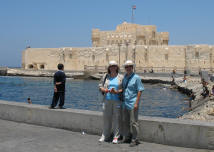 |
|
|
|
While in Alexandria, we also got to see the catacombs of Kom El Shugafa (no photos), & the Kayet Bay Fortress (above and to the right). We enjoyed the Mediterranean Sea lapping at the shore and watching the children swim. K&K and Amy wanted to know why there were only boys in the water. Sam told us that Muslim women just did not swim in public - it was a matter of religion and keeping their bodies covered in reverence. This area was the
site of one of the Seven Wonders of the World - |
||
| Day 9 - July 2 | ||
|
Today, we went to the Egyptian Museum, St. Sergius Church, Ben Ezra Synagogue,
Old Cairo, & the Khan El Khalili, bazaar district. Although each were
wonderful, we seem to only have one photo in the bazaar district. |
||
|
Milan |
||
| Day 10 - July 3 | ||
|
|
When we arrived in Milan we were exhausted. We grabbed a train then the metro & dropped our bags at the George Washington Hotel. Next we set off for Castello Sforzesco. The castle has seven centuries of history. As a past fortress, castle for dukes, army barracks, and now, a museum, the structure is impressive. On the way back we stopped at the Kiss Bar and had dinner and some Italian wine at the tables on the sidewalk. |
|
| Day 11 - July 4 | ||
| Today we spent the morning at Duomo di Milano (the Duomo Cathedral of Milan) & in the Piazza del Duomo, the square around the cathedral. Its statistics are amazing. Dating back to the 1300's, Duomo has almost 3,500 statues, is located on almost 40,000 square feet, has the highest spire at 350 feet tall (topped with a statue of the Madonna on it), 40,000 people can easily fit inside, and is one of the top three largest cathedrals in the world. You can walk up to the roof section and tour the entire building. Below is a picture of Bob & K&K with the close up of the same picture. | ||
|
|
|
|
|
|
The view on the left is of the Piazza del Duomo from the roof of the cathedral. On the right is K&K, and Bob & Amy in the plaza. |
|
|
|
Unfortunately for us, thankfully for the cathedral, the front was undergoing repairs. Its beauty is still apparent. As is our custom, we lit a candle in memory and prayer for those who are not with us anymore. |
|
|
In the afternoon, we visited the Museo della Scienza e della Technologia (the Museum of Science & Technology). We were very impressed with the display of models of Leonardo da Vinci's inventions & designs. The museum is fabulous, but after taking almost 250 pictures, the camera was as tired as we were - it didn't want to come out of its case as much, so we let it rest. We went to the grocery store, bought dinner and wine, and had a delightful time resting in our room till our early morning flight home. |
||
| Day 12 - June 5 | ||
|
It was another wonderful trip! We all got back just before midnight on the 5th, after another 20 hours on the move - due to long layovers. Mom, again, took care of Tai Chi, our pekinese at her house - Tai & Tiki (mom's peke) seemed to have a great time while we were gone. THANKS MOM!!! |
||
![]()
Return to the Kini and Kimi Home Page || Return to Bob & Amy's Home Page
Please write us at bobamy@charter.net